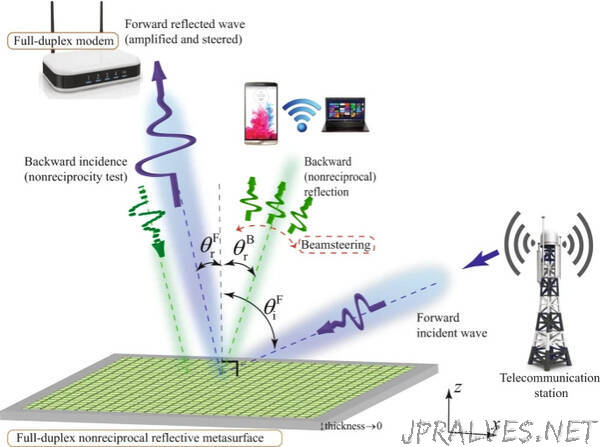
“Your office wall might play a part in the next generation of wireless communications.
ECE researchers Professor George Eleftheriades and postdoctoral fellow Sajjad Taravati have shown how reflectors made of metamaterials can channel light to enable more wireless data to be transmitted over a single frequency.
They project that this newly realized property — called ‘full-duplex nonreciprocity’ — could double the capacity of existing networks. The intellectual property (IP) for the team’s proof of concept has recently been transferred to the Montreal-based startup LATYS Intelligence Inc., cofounded by alumnus Gursimran Singh Sethi (ECE MASc 2T0).
“This is happening,” says Eleftheriades. “Within the next three to five years this technology will be adopted.”
Metamaterials are synthetic structures composed of building blocks that are smaller than the wavelengths of light they are designed to manipulate.
The material used by the team is composed of repeating unit cells about 20 millimetres in size. This means that to wavelengths of light larger than that, such as microwaves — the type of light used to carry cell phone signals and with wavelengths in the range of several centimetres — they appear to form one homogenous object, a metasurface.
Microwaves reflect off the metasurface, but they do so in an unusual way, exhibiting a property known as nonreciprocity.
“When you’re driving and look in the rear-view mirror, you see the driver behind you. That driver can also see you because light bounces off the mirror and follows the same path backwards,” says Eleftheriades.
“What’s unusual about nonreciprocity is that the incident angle and the reflected angle are not equal. To be specific, the backward path for the wave is different. Basically, you can see someone, but you cannot be seen.”
In addition to this functionality, these metamaterials enable you to steer and amplify incoming beams, which is useful in many applications, from medical imaging and solar panels to satellite communications and even nascent cloaking technology. With an added capability to steer the reflective beam, new intelligent metasurfaces could make a significant mark on wireless communication.
“In everyday experience,” says Eleftheriades, “a microwave emitted from a tower reaches its intended terminal point, like a modem, and then goes back to the telecommunication station. That’s why, when you have a conversation on your cellphone, you do not talk and listen on the same channel. If you did, the signals would interfere and you wouldn’t be able to separate your own voice from the voice of your partner.”
Today’s 5G features only ‘half-duplex’ links. Essentially, the 5G signal uses slightly different frequencies, or the same frequency but at a slightly different time, to avoid interference. The time delay is imperceptible to the user.
The full-duplex architecture developed by Eleftheriades and Taravati means that one can talk and listen on the same channel at the same time. Unlike other metamaterial technology, it spatially separates the forward and backward paths within the one frequency — doubling the system capacity. Their research is presented in a paper in Nature Communications.
While full-duplex functionality does exist in a limited capacity in military-grade radars, in its current design it is unsuitable for consumer applications, such as mobile devices. This is because current full-duplex transceivers are made of bulky and expensive structures comprising ferrite materials and biasing magnets to manipulate the beam.
“We propose a completely different mechanism. No magnets or ferrites. Everything is done using printed circuit boards and silicon electronic components such as transistors,” says Elefthreriades.
The broad applicability of these intelligent metasurfaces is what excited LATYS’s development team.
“Tunable, asymmetric radiation beams in both the reception and transmission states have incredible potential to address some of the most pressing and major challenges in the wireless communication industry,” says Sethi. “By spatially decoupling the receive and transmit paths, we can create ‘true full-duplex systems’ that can support bidirectional communication at the same time and the same frequency. This will allow LATYS products and prototypes to gain an edge over competition and much traction, especially in radio-hostile environments such as industrial automation, IIOT and 5G applications.”
ECE Chair Professor Deepa Kundur has often seen this research cycle in the department. “It’s a good illustration of one of the many ways engineering advances,” she says. “A breakthrough proof of concept, such as Professor Eleftheriades and Taravati’s, clears a path to better technology — and then industry picks up the baton.”
“Just imagine,” says Eleftheriades, “as we’re integrating some of these surfaces in the walls of buildings, researchers are hard at work on the next iteration of ‘better.’””
